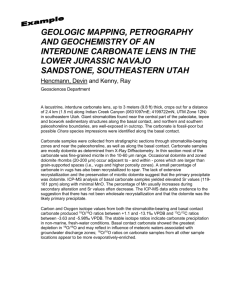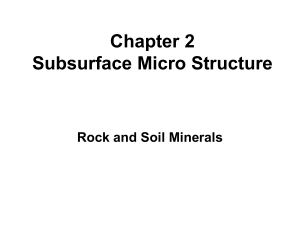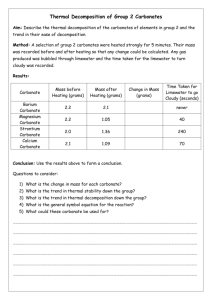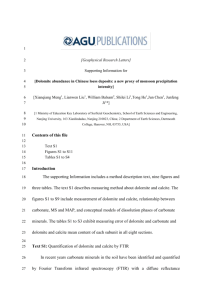Dolomites of Italy
advertisement
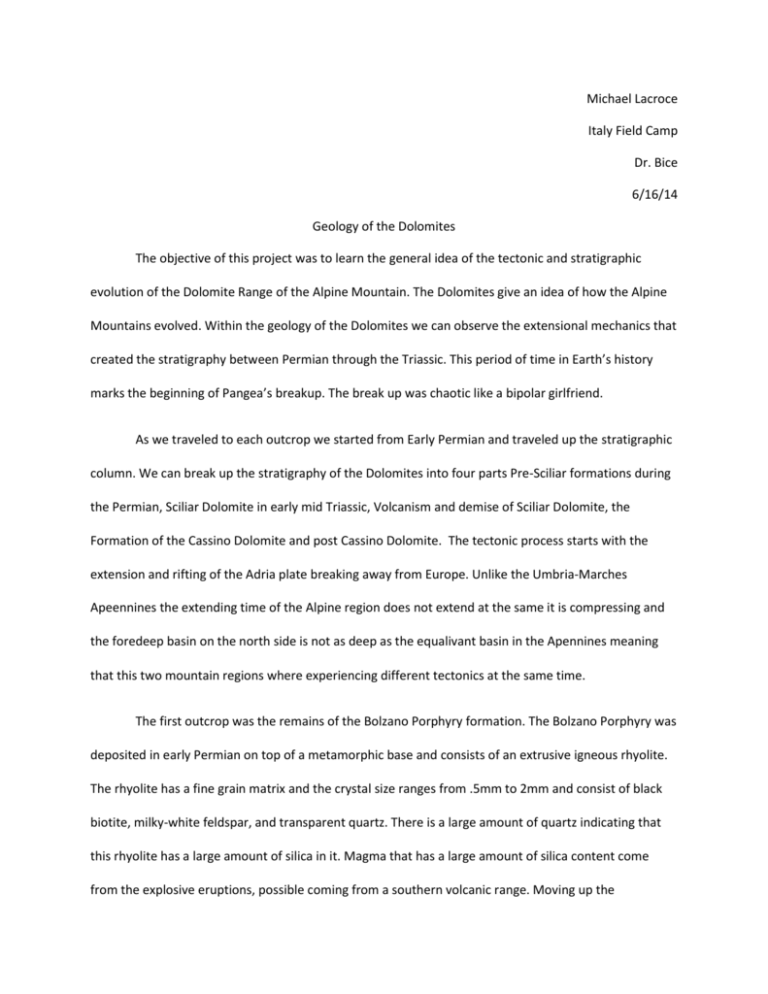
Michael Lacroce Italy Field Camp Dr. Bice 6/16/14 Geology of the Dolomites The objective of this project was to learn the general idea of the tectonic and stratigraphic evolution of the Dolomite Range of the Alpine Mountain. The Dolomites give an idea of how the Alpine Mountains evolved. Within the geology of the Dolomites we can observe the extensional mechanics that created the stratigraphy between Permian through the Triassic. This period of time in Earth’s history marks the beginning of Pangea’s breakup. The break up was chaotic like a bipolar girlfriend. As we traveled to each outcrop we started from Early Permian and traveled up the stratigraphic column. We can break up the stratigraphy of the Dolomites into four parts Pre-Sciliar formations during the Permian, Sciliar Dolomite in early mid Triassic, Volcanism and demise of Sciliar Dolomite, the Formation of the Cassino Dolomite and post Cassino Dolomite. The tectonic process starts with the extension and rifting of the Adria plate breaking away from Europe. Unlike the Umbria-Marches Apeennines the extending time of the Alpine region does not extend at the same it is compressing and the foredeep basin on the north side is not as deep as the equalivant basin in the Apennines meaning that this two mountain regions where experiencing different tectonics at the same time. The first outcrop was the remains of the Bolzano Porphyry formation. The Bolzano Porphyry was deposited in early Permian on top of a metamorphic base and consists of an extrusive igneous rhyolite. The rhyolite has a fine grain matrix and the crystal size ranges from .5mm to 2mm and consist of black biotite, milky-white feldspar, and transparent quartz. There is a large amount of quartz indicating that this rhyolite has a large amount of silica in it. Magma that has a large amount of silica content come from the explosive eruptions, possible coming from a southern volcanic range. Moving up the stratagraphic sequence the next outcrop is the Val Gardena sandstone. The sandstone is thinly bedded and has well rounded clast made of the rhyolite from the Bolzano Porphyry. This depositional environment of sediment came from a fluvial river breaking up the Bolzano Porphyry creating a well rounded sandstone. In the late Permian transgression of the Tethis ocean created a lagoon that marks the beginning of the Bellerophon Formation. The ocean continued to push the lagoon on land and the exposed Bellerophon started to evaporate creating gypsum. This is shown in Figure 1. The gypsum we observed had pressure solution and was folded. After plotting the fold axis Plot 1 we see that the pressure solution was created from the same mechanism that folded the gypsum. This was from the Paleocene/Jurassic compaction that occurs in the region and not from the volcanic intrusions. As transgression continued the Werfen Formation was deposited in a deep ocean environment. The Werfen formation consists of limestones that are inter bedded with shale and marly layers that are cut up into eleven different smaller layers. The first layer called Orizzonte di Tesero that is deposited over the Bellerophon Formation contains the boundary between Permain and Trassic. At this boundary is the worst extinction in Earth history killing around 97 percent of the species on earth including the very abundant trilobite. There is not enough evidence yet to declare what caused the PT extinction but current research suggest that a high level of volcanism peeked through a huge coal layer in the ocean crust creating toxic gases such as hydrogen sulfide which triggered an abrut climate change and made the ocean toxic. However more research and evidence is need for this hypothesis. Once the Contrin Formation was formed (another deep sea deposit) interpretation indicates that normal faulting occurred. We do not see these faulting we call them blind faults. This interpretation is from observation that some of the Sciliar Dolomite is on top of the Contrin Formation and some is on top of the Livinallongo Formation. The normal faults that are similar to the Umbria-Marche region of the Appenines created some series of horse graben formations with the Livinalongo begin deposited in the basins of the normal faults as seen in Figure 2. Once faulted, the Contrin and Livinalongo where in a perfect environment for subsiding to occur, creating the carbonate platform called the Sciliar Dolomite. Carbonate platforms are formed from living animals like coral, sponges, plankton and alge creating CaCO3 and growing on top of each other pushing the older animals down and outwards in order to stay in a favored subsidence level. This carbonate platform started on the horst tops of the Contrin Formation and propagated out into the Livinallongo Formation as seen in Figure 2c. As extension continued through the lower mid Triassic intrusive dikes started to break through the crust. It created a huge volcano around Predazzo and volcanism zone that extended between Cavalese and Marmolada. These dikes split through the Sciliar Dolomite carbonate platforms and exploded pieces of the carbonate platform creating breccia. This episode of events created the Caotico eterogeneo. This layer consisted of brecciated limestone and has a matrix that is angular sand grains indicating a high energy environment. The brecciated limestone also had a low grade metamorphism to it indicating that it is a hot breccia. This is seen in Figure 3. As volcanism continued it covered the entire region with a layer we call volcanics which is layer of igneous rocks and volcanic ash. Volcanism eventually stopped probably from less serve extension. During this time the Marmolada to the San Cassiano formations where deposited in the graben basins. The first formation we saw was the Marmolada which has a sand grain matrix with huge volcanic conglomerate. The next formation up the river is the La Valle Formation that consist of turbidites and marlys. These turbidites have are quartz sandstone and very silizious. As we start going up the river the turbidites get thicker and we walked into the San Cassiano Formation we start seeing turbidites that are made of carbonate. This is an indication of a second generation of a carbonate platform and the more carbonate limestone that is in the turbidites the closer we were to the second generation of carbonate platforms. There are also fossils in the upper La Valle formation from the animals that make up a carbonate platform giving us more evidence that the turbidites formed from carbonate platforms. After plotting the paleo currents of the turbidites we saw a flow direction from the southwest to the northeast Plot 2. This was constent with where we were located in the river valley since some of the second generation platform (Cassiano Dolomite) was to the south of us. During the Mid Triassic after the San Cassiano was deposited was the start of the second generation of carbonate platforms. Similar to the Sciliar Dolomite the Cassiano Dolomite started on top of the horsts where the volcanic layer remained with no other formations deposited on top of it. Like the first generation, the second generation started on the horst tops that provided a favored subsidence level and propagated outward over the San Cassiano as seen in Figure 4. Unlike the first generation the Cassiano platform continued to propagate until it filled the entire region including the horsts and grabens. However, this continuous growth stopped because extension in the region stopped which ended subsidence. This was the main difference between the first generation Sciliar Dolomite and second generation Cassiano Dolomite. The Cassiano Dolomite is also more dolomitized, indicating it was exposed to the ocean and fresh water for a longer period of time. Unfortunately we could not see the rest of the stratigraphic sequence. To sum it up it was deposited in an ocean environment and eroded away. It experienced similar events to the Jurassic Eocene in the Umbria- Marches region of the Apeninne, but the difference is that this area is not flysch. Flysch is sediment deposits that get dumped in a forearc basin. This are is not a forarc basin just a horst graben basin created from extensional normal faults. To conclude, the Dolomite Region is a great window into the tectonic events that occurred in the Permain Trassic periods of Italy. This extension created a great environment for a carbonate platform to form. As the extension became more intense dikes intruded through the crust creating a volcanic region that destroyed the first generation of carbonate platforms. As extension became less serve and slowed down it created another subsidence environment and another generation of carbonate platforms were created. Once extension stop, so did subsidence therefore stopping the carbonate platforms growth. These carbonate platforms oxidized into the dolomites seen today. The region is a beautiful and unique creation of nature that exposes Triassic formations not seen anywhere else.

